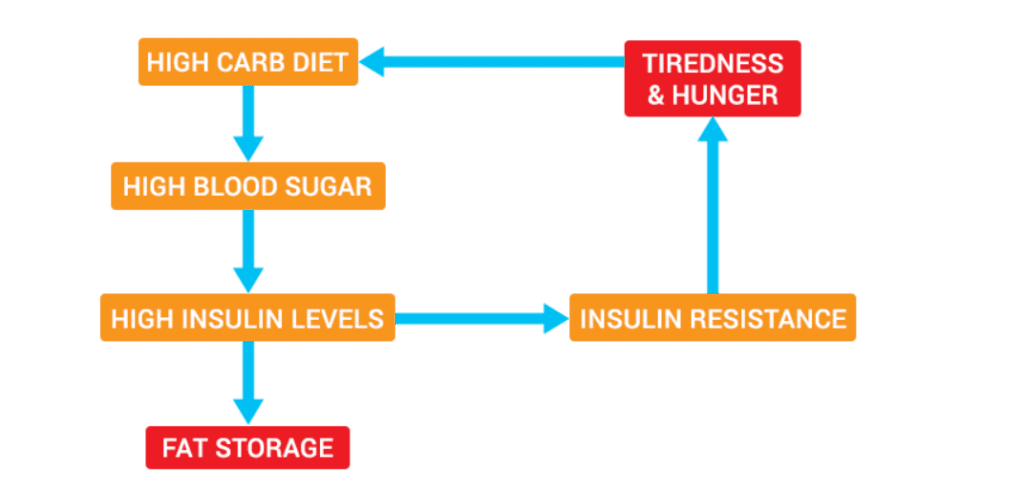Macro counting is a way of tracking what you eat to achieve your optimal health, body composition, and performance goals.
Instead of focusing on calories for weight loss, you’re making sure your diet has a certain number of macronutrients (protein, carbs, and fat). It’s a methodical approach to dieting that won’t compromise your metabolism, muscle mass, or health.
Figuring out your macros can seem daunting at first, almost like putting together a puzzle. And who wants to always track what they eat?
While it’s a skill you learn over time, we’re going to outline what you need to know about counting macros for weight loss. This will get you set up with what you need to get started.
Jump to:
- What Is The Macronutrient Diet For Weight Loss?
- What Are Macronutrients?
- Macronutrient Breakdown For Weight Loss
- Is Counting Calories or Macros Better For Weight Loss?
- Who Should Be Counting Macros?
- How To Use Macros To Lose Weight?
- Calculate your calorie requirements
- Log your macro and calorie intake
- Reassess your macronutrient ratios
- Do I Need to Count Macros Forever?
- Benefits of a macronutrient diet
- Lose weight more efficiently
- Downsides of Macronutrient Diet
- Hard to reach macronutrient goals
- Macronutrient counting is complicated
- Choosing the right time
- FAQS
- What is the best macro ratio to lose weight?
- How do I know my macros for weight loss?
- How do I adjust my macros to lose fat?
What Is The Macronutrient Diet For Weight Loss?
Bodybuilders have long used the power of macronutrients to get a very lean physique by a specific date. But for people looking to lose weight, it is more about learning how your body functions. And it’s about eating nutrient-dense foods in the right portion size.
Rather than a quick fix diet, it’s a weight loss strategy personalized just for your body. Throughout the process, you’ll understand what your body needs to perform at its peak and make the best food choices to fit around your lifestyle – not the other way around. It’s also called flexible dieting for a reason!
What Are Macronutrients?
Macronutrients (or macros), refer to the three main nutrients that provide your body with energy, which are protein, carbohydrates, and fat. Macros contribute energy or calories, and each has a different effect on the body. By counting these macros you’re strategically planning the energy that your body receives, giving you more control over weight loss or muscle gain.
Most foods contain more of one macronutrient than the other so they’ll fall under that category. For instance, multigrain bread is considered a carbohydrate even though it also contains some protein. Understanding which category foods come under can be challenging, but it’s a crucial step. The actual food quality is also important so choose whole, unprocessed foods where possible.

Macronutrient Breakdown For Weight Loss
Here are the three main macronutrients you’ll need to calculate in your macro diet.
1. Focus on lean protein intake
For most people wanting to lose weight, increasing your lean protein percentage is a good place to start. When we consume lean protein, many studies have proven it is beneficial for weight loss as it reduces body weight while preserving muscle mass. That’s because protein is made up of the ‘building blocks’ amino acids, which are essential to build and repair muscles and bones.
Higher amounts of protein help you feel fuller for longer on fewer calories which naturally helps you lose weight. It also speeds up your metabolism so you burn slightly more calories after eating. The percent of protein calories you need depend on your activity levels.
2. Lower your carb intake
When carbohydrates are lower, people tend to feel less hungry and as a result, consume fewer calories. Reducing high-carb foods works to reduce insulin resistance. And when insulin and calorie levels are lower, your body is primed to burn fat rather than store fat.
That’s why low-carb diet plans generally consist of fewer than 130 grams of carbs on a 2,000 calories per day diet or 26% of your daily calorie intake. Although, this kind of diet is generally not sustainable in the long run.

3. Include fats in your diet
If you significantly cut carbs from your diet you will need to use fat as a source of energy. Many low-carb diet plans are also high in this macronutrient for this reason. Your body will start to use the fat you consume and the fat stored in your body for this purpose. That’s why it’s important to determine exactly how many fat grams you need to maintain optimal energy.
Is Counting Calories or Macros Better For Weight Loss?
Calories refer to the overall energy that food contributes. Reducing your calorie intake combined with increased activity will result in weight loss. But by counting calories alone, you’ll only have control over three things; weight loss, weight gain, and weight maintenance.
Instead, by tracking macros instead of your daily calorie goals, it takes it a step further. Controlling the types of nutrients your body receives gives more control over lean muscle gain and body fat loss, appetite suppression, blood sugar, hormone balance, and overall energy. Naturally, this all has an influence on weight loss.
Counting macros is advantageous because not all calories are equal. With calorie percentages, you could end up comparing a nutrient-rich food like a large apple, with a bag of salty potato crisps. Both of these contain roughly 100 calories but one is healthier than the other.
Who Should Be Counting Macros?
The macro diet is a nutrition strategy that best suits people who want to take charge of what they consume for a very specific outcome. A study by the Journal of Eating Behaviors, comparing restrictive dieting with flexible (macro) dieting, found that men and women had a lower BMI, and less physiological distress when they had more self-control over their food intake.
The macro diet is not only for fitness enthusiasts, but it can help people wanting to lose belly fat or get better results than they have seen with restrictive low-fat or low-carb diet plans.
How To Use Macros To Lose Weight?
For weight loss, you need to burn more calories than you put in your body while getting enough protein to maintain muscle mass to keep up your metabolism. When combined with a healthy lifestyle, many people can lose weight with a higher protein/lower carbohydrate percentage.
Acceptable macronutrient distribution ranges vary with each person so there is no ideal macronutrient ratio. For healthy weight loss, nutritionists often recommend the 40/30/30 macro intake as a good place to start. It has the following percentage of calories:
- 40% calories from carbohydrate sources
- 30% calories from protein sources
- 30% calories from fat sources
But you need to create a calorie deficit if you want to lose weight. Decreasing around 10-20% of your daily maintenance calories is enough to help you lose weight. You can determine your calorie deficit by using a macro calculator.
Calculate your calorie requirements
Once you know how many daily calories you burn, you can then determine your calorie deficit. It’s that simple. But first, you need to work out your BMR (basal metabolic rate) and TDEE (Total Daily Energy Expenditure).
BMR is how many calories your body consumes before physical activity. Most calculation formulas, like the Mifflin St. Jeor or Harris-Benedict equations, contain these elements:
- Gender
- Weight
- Height
- Activity
You can use the formula like the one below, but the fastest way to determine your BMR is to use an online calculator.
Once you have your BMR, it’s time to determine your TDEE or the amount of calories you need to support your body including physical activity. TDEE is calculated by adding together four main components, basal metabolic rate, thermic effect of feeding, exercise energy expenditure, and non-exercise activity thermogenesis.

It is the same formula as the BMR, except that you multiply it by 1.2 – 1.9 depending on your activity level. You can also use a calculator to find your estimate. Personal trainers or healthcare providers can provide more customized nutrition plans.
- Sedentary: x 1.2 (little to no exercise)
- Lightly active: x 1.375 (light exercise less than three times per week)
- Moderately active: x 1.55 (moderate exercise three to five times per week)
- Very active: x 1.725 (heavy exercise four to five times per week)
- Extremely active: x 1.9 (heavy exercise throughout most of the week)
After you discover your BMR and TDEE, you need to make sure your caloric intake is less than your TDEE calories. For example, if your TDEE result is 2,300 calories per day, you’ll need to consume less calories to lose weight.
You want to find a macro diet plan that can serve you for six to eight weeks. Always consider your own preferences in your diet plan. For example, if you’re an athlete, vegetarian or vegan your calories from carbs might be higher. These all need to be factored into your macronutrient split calculation, so it can take some experimenting to get right.
Log your macro and calorie intake
There are many methods of food tracking. Options include logging what you eat on a notebook or a fitness tracker, with a large food library and the ability to scan nutrition labels so the process is simpler. Track everything from meals to beverages and every little snack that you consume.
While there’s conflicting consensus about how close you need to get to your macro goals, a good aim is within 5 grams of all your macro targets. Once you’ve reached at least one macro target, aim to get all three macros within five to 10 grams of your macro totals.
Reassess your macronutrient ratios
It’s common to notice that at least one macro is far from where you would like it to be. For many, this is protein. If you struggle at first, pick one macro first to focus on and make changes to meet that macro. That way it’s less overwhelming and you’re more likely to stick to your new eating plan.
If you can consistently reach all your macro targets after several weeks, it’s time to reassess. If you’re feeling and performing better and feel less hungry most of the time, then it’s a good sign that you’re on the right track.
Do I Need to Count Macros Forever?
It’s going to take at least four weeks to start seeing results but it depends on your current weight and weight loss goals. For example, if you have a lot of belly fat to lose it could take months or even a year to reach your target weight. It can take time to find the right macro ratio, especially if you have lifestyle habits that get in the way. Seeing results is about consistency over perfection.
Benefits of a macronutrient diet
The macro diet is beneficial, depending on your personal goals. That’s if you can stick with it. Here are the top benefits.
Learn about your nutritional needs
By counting macros, there’s a greater connection with what you eat. Rather than food being ‘bad’ or ‘good’, it just becomes fuel for your body. Food choices and portion sizes are determined by you which can lead to a positive change in attitudes toward food over a period of time.
Gain muscle while losing weight
Macro manipulation can offer greater control and flexibility for weight loss. It’s proven that exercise combined with adequate amounts of protein is more effective in preserving lean mass during weight loss. That’s why macro tracking is helpful in building muscle while reducing body fat during a cutting phase.

Lose weight more efficiently
Portion sizes naturally get smaller when you count macros. That’s because a higher intake of nutritional food leads to steady energy levels and increased fullness after eating. Rather than binging on sugary foods for a quick energy boost, you’ll reach for healthy snacks instead.
Downsides of Macronutrient Diet
The macro diet can prove challenging for many people, here are the disadvantages.
Hard to reach macronutrient goals
For people wanting to lose weight fast, it can be tempting to set your macros too low to be sustainable. You might notice that you’re not getting the results you want because you’re craving food or have no energy.
Some calculators can also put the amounts of protein levels up to an impossible to reach target which makes eating a chore. If you can’t meet your protein requirement goals or if a low-carb diet plan doesn’t work for your activity level, it might be time to revise your macro targets.
Macronutrient counting is complicated
To reach your macronutrient goals you need to plan and prep meals ahead of time. It takes more time to assess your weekly grocery shop and figuring out your exact macro split requires time and effort. All this can make macro tracking frustrating in the beginning.
Choosing the right time
You need to commit to tracking everything that you eat. If you always miss logging your food, then it might be best to wait until you have more time. This is a common reason why many people fail at the macro diet, but it often becomes easier after a period of time.
FAQS
What is the best macro ratio to lose weight?
In general, the 40/30/30 ratio is considered a healthy weight loss target. Aim for 40% of your diet to contain carbohydrates, 30% from protein, and 30% from fats. This offers a balanced approach to steady weight loss.
How do I know my macros for weight loss?
To identify your specific macro amounts, multiply each by the total number of calories. For instance, on the 40/30/30 ratio, multiply each macro by four for carbs, three for protein, and two for fat. This will give you the total calorie allowance for each macro per day. Then, divide this number using the same ratio (that’s 4, 3, 3). This will give you the exact calories per gram to eat of each macro.
How do I adjust my macros to lose fat?
If you want to lose weight, reduce your calorie intake by 10% and then up to 20%. Reduce carbs and increase protein and fat macronutrients. Aim for 0.7 – 1.0 grams of protein per pound of body weight and 0.25-0.4 grams of fat per pound of body weight.














